Small spaces gardening
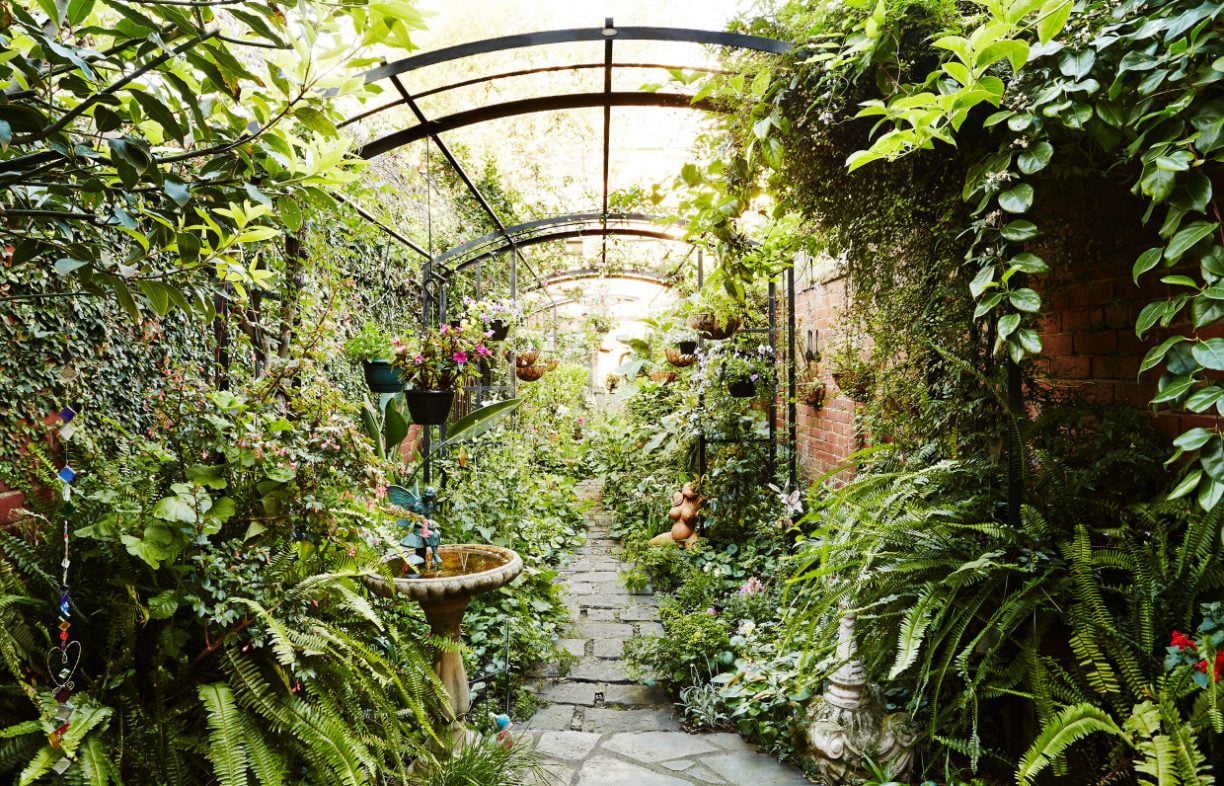
Higher density living affects outdoor spaces as well as our homes – but small in size doesn’t have to mean short on greenery. Kate Smalley from Small Spaces Garden Design explains how to make the most of courtyards, balconies and vertical spaces.
Increasingly, our gardens are becoming smaller spaces, whether that means a compact back garden, a courtyard or a balcony. But this doesn’t mean you can’t have abundant greenery. A small garden can be a little oasis in the midst of our urban sprawl. You can create your own microclimate and cool your space, even grow some trees. You just need to think on a smaller scale – you might not be able to have a 20-metre lemon-scented gum in your courtyard garden, but maybe you can plant a grafted variety. Look for grafted corymbia or eucaplytus, or other small tree cultivars, like the crepe myrtle ‘zuni’.
The principles of garden design are essentially the same for small or large gardens. However, in a small space there is nowhere to hide, so all the components need to work well. Part of having a sustainable small garden is getting it right the first time: you don’t want to have to reinvent the whole thing in 12 months because what you put in the first time didn’t work.
Start with the fundamentals
Soil: A vital ingredient of any garden is the soil. For courtyards and small backyards, my driving principle is to work with the soil that’s there already.
Clients often ask me to remove the existing soil and replace it with new. I usually resist this and prefer to build on what’s there; unless it’s clearly in really bad shape – full of builder’s rubble or contaminated from paint or concrete runoff.
If you have a really sandy soil, add compost and other organic matter and over time this will build up the soil. At the opposite end of the scale, if it’s a heavy clay, then add gypsum.
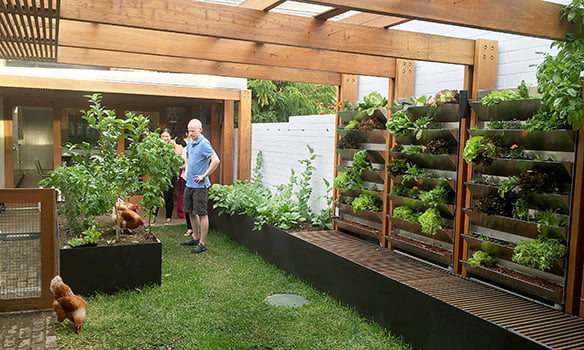
You should also use plants that ‘like’ your soil type. For a sandy soil, choose plants that suit a coastal environment; options include westringia, leucaphyta, melaleuca, anigozanthos (kangaroo paw). Look to Western Australian natives for some inspiration. With clay soils, select plants that like poor drainage such as callistemons and bottle brushes. Lomandra grasses will also cope well – they’re tough and will cope with almost anything!
One of the most important things for any soil is to add compost. Compost will increase the organic matter in the soil – it’s food for your soil. You can buy compost by the bag or make your own. Even a small courtyard or balcony can host a worm farm or Bokashi bucket on the kitchen bench which will reduce your landfill load and feed the soil at the same time.
A big part of any small garden is likely to be pots. Use potting mix rather than soil in pots. Pots need good drainage and potting mix is designed to deliver air and water to the roots. Remember, you get what you pay for. You’ve already invested in pots, planters and plants, so don’t cut short on the potting mix. Use the one that is right for your plants and check if it has fertiliser added to the mix; this can sometimes explain a difference in cost. If it doesn’t include fertiliser, then add a pelletised slow-release fertiliser to your pots at the time of planting. Don’t add organic matter to potting mix as this will actually disrupt drainage and air flow; pots are an artificial environment, so the usual rules don’t necessarily apply.
Specialised potting mixes are particularly beneficial when planting specific groups of plants. If you are growing succulents then use a succulent mix as it has a more open structure than regular potting mix and is good for both succulents and orchids. The same goes for specialised vegie or native potting mixes; they’ve been designed to cater to the specific requirements of those plants. A good all-round, all-purpose potting mix is ideal for small potted trees, citrus or other fruit trees.
Light: As with any garden, the amount of sun your space receives will dictate what it is possible to grow. Is it shady for most of the day, does it get morning or afternoon sun, or is it a full sun position? This will be dictated by the aspect – which way the garden faces – and any surrounding shade.
If your garden faces south or is shaded by buildings or large trees, then it may be difficult to grow vegies or fruit trees; instead, you can grow parsley, mint and basil. Citrus trees will be fine but won’t necessarily produce any fruit.
The sun can also heat up your walls and create a microclimate. This can work in your favour with some plants, but it will also add to pots drying out.
Water: All plants need water, even succulents. Of course the amount will vary depending on the choice of plants, but water is still essential.
It’s surprising how many balconies have no access to a tap, so you may find yourself carrying a bucket or watering can outside to do the watering. If that’s your situation, you’ll need to think carefully about the plants you choose and how often you’ll need to water them.
Whether your garden is on a balcony or your backyard, be realistic about how often you will hand-water your pots or garden beds. Depending on the aspect (and the season), what you plant may survive on a once-a-week watering, but it won’t necessarily thrive.
If you can, set up a drip irrigation system and connect it to a battery-operated timer; that way you can be assured your plants are getting watered regularly. It’s not hard and there are lots of resources online to help you.
Alternatively, consult your local specialist irrigation supplier to help you design a system to suit your needs. Take a plan of your garden to the supplier; it doesn’t need to be complex, just a rough layout with an overall measurement of the area. They’ll also want to know your water flow – check this by timing how long it takes to fill a nine-litre bucket with the tap on full.
One of the potential pitfalls with pots is that the soil dries out and becomes hydrophobic. When this happens the water runs straight through the pot and nothing reaches the plant roots. You’ll see it on the ground instead!
If this happens you need to rewet the pot. In technical terms you do this via what’s called mechanical agitation or, more simply, by making mud pies! Use a hose or watering can to slowly add water to the pot, and stir it in as you pour to mix the water and potting mix together. Eventually the potting mix will hold the water.
As an alternative to standard pots and planters, consider using self-wicking pots, which have a reservoir of water under them which ‘wicks’ up to water the plants. These are ideal for balconies as they require less frequent watering and deliver the water to exactly where it’s needed – the roots.
Which small space?
Balcony: A balcony garden, by definition, is most likely in an elevated position, so it’s more prone to the drying out effect of wind. As previously mentioned, small pots dry out more quickly, so use larger pots where possible.
You might think that sitting a pot in a saucer of water would help prevent your pots from drying out, but this stops oxygen from getting to the root zone – roots need air as well as water!
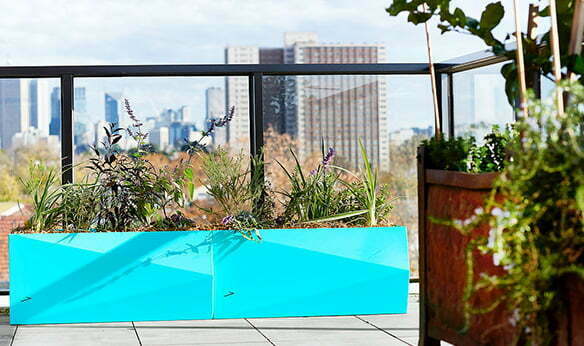
Using bigger pots or planters will also allow you to grow some small trees. So for your balcony, consider larger planter troughs and pots and self-wicking planters, especially if there is no tap on hand.
You do, however, need to consider the weight of the pots when using them on a balcony. For example, if you are looking at planting, say, three long troughs, it would be better to use lightweight fibreglass planters, at 10kg each, rather than concrete or stone, at maybe 60kg each. Not only is it better not to put all this weight on your balcony, it’s a lot easier getting them up there as well.
Lightweight planter boxes are a great option, keeping the weight load down. They don’t need to be confined to charcoal or off-white – you can paint them to match your decor. Pick up on an accent colour in a cushion or rug, and bring some colour outside.
A wicking bed or planter box could give you close to a square metre of garden to plant. In this, you could easily grow some seasonal basil, a couple of cherry tomatoes, and lettuce and spinach: the essentials for a summer salad for every day of the week!
Courtyards: When it comes to a courtyard, you’ll have slightly more options than on a balcony. The weight of pots isn’t such a problem, and you could even build raised garden beds or plant straight into the ground.
If your courtyard is already paved then you may want to work with what is there.
The pavers will either be on a concrete or sand base. If the base is concrete this is more permanent and harder to adjust. Of course this can also be a bonus, as the paving is less likely to move over time and won’t grow weeds in the gaps.
If the area is paved on a sand base you could potentially lift up your paving and re-lay it to suit your design.
Both options really come down to cost and the balance between reusing or waste. If you do decide to pull up paving, make sure you recycle it. Pavers on sand could go on Freecycle or to your local tip shop. If it’s a concrete base then make sure your skip is going to a concrete recycler and not landfill. (For more on paving options see Sanctuary 28.)
Often courtyards have very narrow garden beds and that can be a challenge. The building or boundary fences may cast a shadow over the beds, blocking light and much of the rainfall as well. And have a look over the fence at your neighbour’s place: if there are large established trees, this is great for shade and a green canopy, but those plants will also be drawing moisture from the soil.
When planting into these areas try creating some depth of space by espaliering or training a climber on to the wall and planting a low border below. This creates more visual depth than, say, planting a hedge all along. If you have an existing hedge maybe you could pleach it by removing all the lower growth to, say, one metre above ground level, exposing the trunks. Then plant a low border or ground cover. Instantly this creates more depth.
The best way to manage water to these areas is by directing surface irrigation directly to the ground. Use drippers along the length of the bed or plastic spikes that direct the water into the ground, the sort that take a soft drink bottle upside down. Or use a hose on a very slow drip, but remember to set a timer to remind yourself to turn it off! The idea is to release the water into the area slowly rather that in a rush where it is likely to overflow to other areas.
If your garden hasn’t yet been built, then consider creating one large garden bed with green walls for borders, such as a narrow hedge, climbers or a vertical garden. A little bit of depth to a garden bed allows room to plant a small tree in the centre, mass some groundcovers under, and grow a climber up the fence. This gives you three layers instead of one, optimising your use of the space.
Vertical gardens: Vertical gardens are a good solution for creating a green wall with loads of interest. The pots or planting pockets on a green wall tend to be quite small, so the plants will ‘bonsai’ due to the restricted root zone: factor this in when you’re choosing your plants.
Try a herb garden with hardy perennials such as oregano, thyme and prostrate rosemary, and useful annuals such as curly leaf parsley and basil. Load up the pots by planting close together. This will give you good coverage and a longer harvest period. But don’t think of it as a one-off planting: if you are constantly harvesting then you may need to replenish your base stock two or three times over the warmer months.
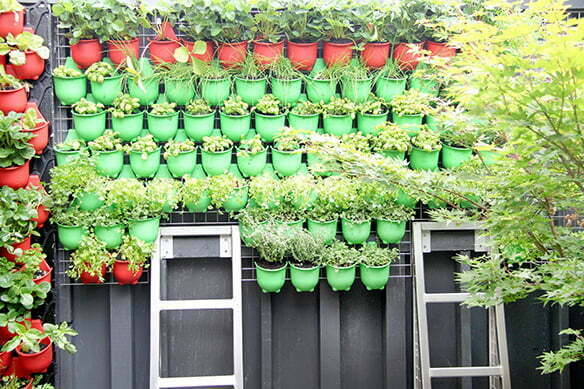
Rather than an edible vertical garden, there are many other options. You could use groundcovers that cascade down the wall to hide the pots, or grasses will create a massed clumped effect. You can play with different textures and colour in the foliage.
This is where aspect and water are really important. Remember, small pots dry out, and elevated gardens dry out, so vertical gardens are best combined with drip irrigation.
Trees
For a smaller garden, you just need to downsize your concept of a tree! Smaller cultivars of larger tree species mean you get their beauty without the large canopy and root mass. It is critical to plant the right-sized tree for your space.
By planting known cultivars, you can easily select a tree that will grow to suit the space, not overwhelm or cause structural damage. The width and height of the tree relates directly to the root mass underground. Consider this when you are selecting and positioning your plant. A general rule of thumb when planting near pipes or buildings is that, if a mature canopy is 5 metres high, then plant 2.5 metres away from any building. You can also consider installing a root barrier, which directs the roots down into the sub soil and stops shallow roots from developing and pushing through to either pipes or building footings.
Irrigation can also play a role here. Regular, infrequent long watering encourages roots to move down into the soil profile. This means there are less likely to be roots in the top half metre or so of the ground, thus reducing the risk of building damage. The tree will also be stronger and more resilient to drought and storm damage.
Maintaining your small space
Now you have a beautiful space that is flourishing with food or just some lovely foliage to soften and connect back to nature. How do you maintain it?
Fertiliser: Use a slow-release fertiliser every six months or so: check pack directions as slow-release fertilisers are designed to break down over different timeframes depending on temperature. Add granulated fertiliser (like blood and bone) every three months. Sprinkle it around the base of the plant like chook food, then water in well. Liquid fertiliser is for short-term boosts. The nutrients are passed out with the water so you need to apply this every two to three weeks for sustained benefit.
Pot maintenance: Large pots containing established trees can be maintained by topping up potting mix on the surface; apply it like a mulch. Prune as you would for plants in the ground. Remove old spent foliage and diseased plant material. Remove cross branching and prune to open up air circulation in the canopy. Established pot plants can be maintained over an extended period (10+ years) by using this method. I have two cumquats, planted circa 1989, that are still going strong in the original pots!
If it is necessary to re-pot I usually like to do it in situ. I prefer not to lug heavy pots around, even if I have access to a trolley. Lay a drop sheet or tarp down to capture all the mess. Tip the pot on its side with a towel or something to cushion and protect the outer edge of the pot.
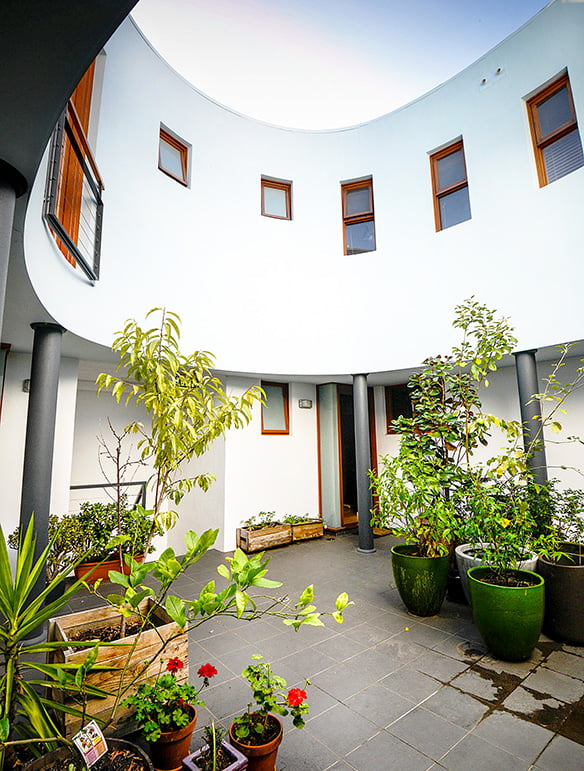
Now try to prize the plant out. Slide a trowel or shovel or something else that is thin, long and narrow down the side of the pot. Work your way around all sides to loosen the potting mix and roots from the inside surface of the pot. Gently pull on the base of the trunk until the plant is out.
Now prune. Don’t be scared of pruning roots; it is the same principle as pruning foliage above ground. The root ball will most likely be full of lots of fibrous outer roots, which shows that the plant is pot bound and is due to be re-potted.
Loosen the root ball by running a knife or secateur blade along the outer layer then gently tease out the roots. Trim off any excess growth you’ve exposed. Any roots that are spiralling around the outside can be cut back to just before the spiral originates.
By reducing the root ball you should be able to refill the pot with fresh potting mix and pot back into the same pot. Once you’ve potted up you need to also prune the canopy. Remove around the same amount of leaf mass as you did roots so it is balanced.
If you are potting up to the next size, follow the same method and just increase the pot size.
Irrigation: Irrigation is critical for any garden. For good examples on how to effectively irrigate your garden we recommend you watch these two Gardening Australia episodes on irrigation: abc.net.au/gardening/stories/s3821145.htm
abc.net.au/gardening/stories/s2321331.htm
More outdoor stories
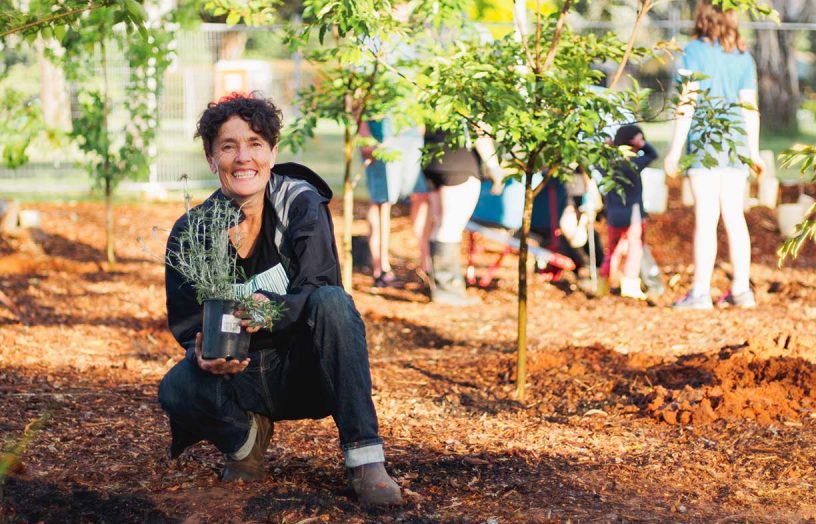 Outdoors
Outdoors
Pocket forests: Urban microforests gaining ground
Often no bigger than a tennis court, microforests punch above their weight for establishing cool urban microclimates, providing wildlife habitat and focusing community connection. Mara Ripani goes exploring.
Read more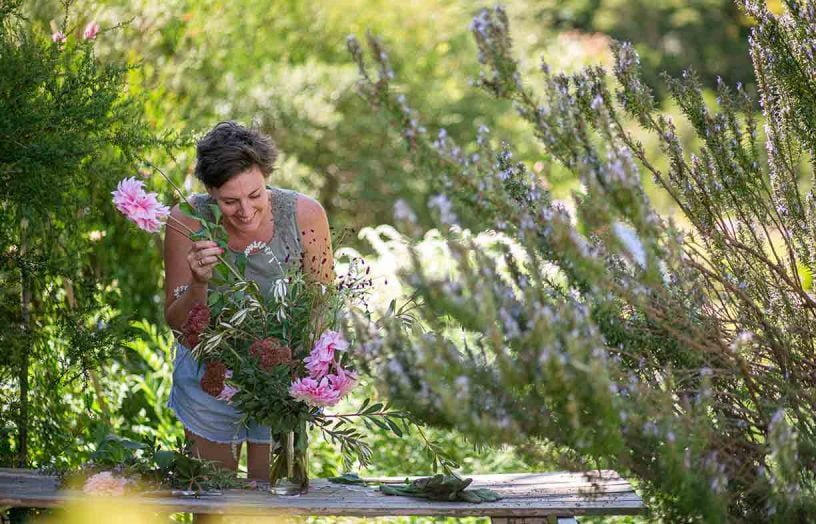 Outdoors
Outdoors
Nourished by nature: Garden design for mental health and wellbeing
There’s plenty of evidence that connection with nature is beneficial for both mind and body. We speak to the experts about designing gardens for improved mood and wellbeing, and what we can do at home to create green spaces that give back in a therapeutic way.
Read more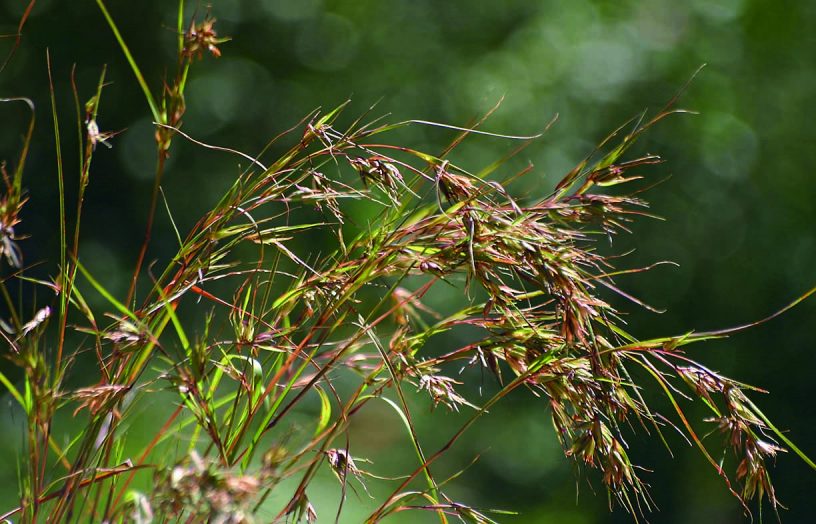 Outdoors
Outdoors
In the line of fire: Plant list
Download a list of popular native species to accompany our Sanctuary 51 article 'In the line of fire: Garden design to reduce the threat of bushfire'.
Read more

